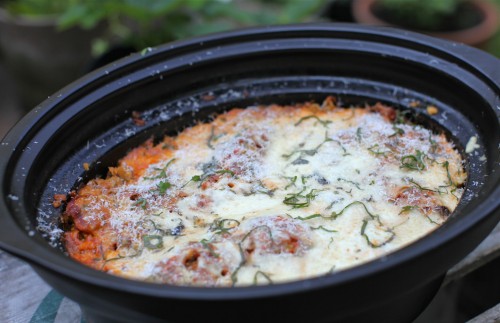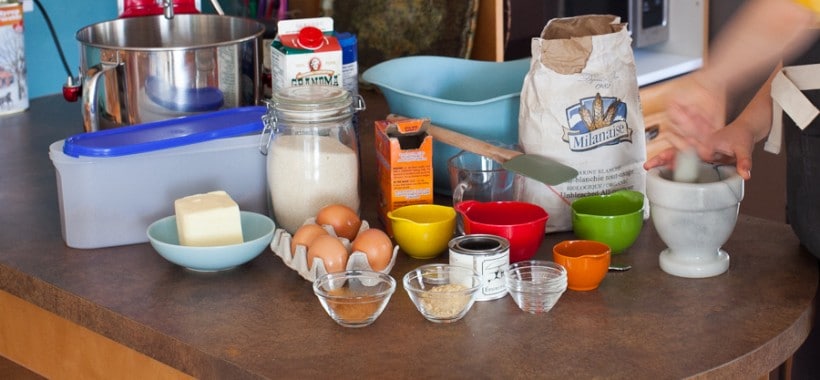5 Secrets of Successful Feeding (recipe: Summer Vegetable Slow-cooker Lasagna)
Maryann Tomovich Jacobsen, MS, RD is a mom of two, registered dietitian, and co-creator of the Fearless Feeding Community in preparation for her first book due out next year. Maryann is also founder and creator of Raise Healthy Eaters and blogs at WebMD’s Real Life Nutrition.
Welcome, Maryann!
As parents, we often define feeding success by the number of foods children eat, especially healthy items. Not only is this definition of success limited, it leaves most parents filled with guilt because children are still learning about food.
As a dietitian and family nutrition expert, I want to introduce you to a whole new way at looking at successful feeding by sharing 5 secrets. This outlook will not only empower you, it just might make you a more confident feeder.
1. Think of your child as a future adult.
How and what parents feed children has a lasting impact on how they will eat into adulthood. For example, if food is constantly used as a reward, children are much more likely to reward themselves with food as an adult. If they are always being nagged to eat veggies, they probably won’t choose veggies when out on their own.
Always think about how the way you feed today impacts your child for life, when they are making choices on their own.
2. Focus on your job.
When I teach classes to moms of toddlers, the light bulbs always go off when I tell them it isn’t their job to get their child to eat. Their job, which is more than enough work, is to provide balanced meals in a positive environment. The child’s job is to decide how much and what to eat of what is offered.
This Division of Responsibility, created by international feeding expert Ellyn Satter, melts away the tension at the table and gives children some choice in the matter. It also helps ensure that children regulate food intake since they are the ones in charge of how much to eat.
3. Keep expectations high and pressure low.
According to a study published in Appetite, children pressured to eat soup not only ate less, but made 5 times more negative comments during the meal than those not pressured. But worse yet, some of the children who finished their clean bowl boasted about it, catching on that eating more food is better.
The key is to have high expectations for eating without all that pressure. Your child doesn’t like a something? That’s okay. Set the expectation that she will in the future because “taste buds grow up too.” Children need many exposures and tastes to move along to food acceptance — and a pleasant environment to learn in.
4. Make meals rhythmic.
Predictable meals are key to successful feeding. This means families eat around the same times, at the table or a designated place, where they can focus on food. In between meal eating is discouraged.
Structured eating helps on so many levels. First it ensures that hunger is the reason to eat and not the TV or boredom. It helps parents prioritize food requests — “no, not today but how about tomorrow during snack time?” And lastly, it ensures that children come to meals with an appetite.
5. See eating from your child’s perspective.
The most overlooked cause of feeding challenges is a lack of understanding for what is going on behind the scenes. A child’s development, both in terms of growth and cognitive changes, has a big impact on why they eat the way they do.
Understanding what to expect, whether it’s rapid growth (infant), picky eating (toddler), the need to fit in (school age) or experimenting by trying different diets (teen years), gives moms much-needed perspective. Often, we blame ourselves for such challenges, when kids are just moving along normal development.
The best way to define successful feeding isn’t in terms of what your child eats, but that she enjoys eating and coming to the table (most of the time) and is being exposed to a variety of food.

Ingredients
- 8 ounces shredded mozzarella cheese divided
- 15 ounces part-skim ricotta cheese
- 2 large eggs
- 1/4 cup freshly grated Parmesan cheese grated
- 1 teaspoon salt divided
- 1 cup carrots shredded
- 3 cups zucchini shredded and firmly packed
- 26 ounces roasted garlic marinara sauce 1 jar
- 8-10 regular lasagna noodles not no-boil
Instructions
- Begin by reserving 1/2 cup of the mozzarella cheese.
- In a bowl, combine remaining mozzarella, ricotta, eggs, Parmesan and 1/2 teaspoon salt.
- Cook carrots in microwave for 2 minutes on high. Stir carrots into cheese mixture and set aside.
- In a separate bowl, stir remaining ½ teaspoon salt into zucchini.
- Spray slow cooker with cooking spray or brush with olive oil. Spread 1/3 sauce on bottom. Gently break 2 noodles to fill and cover bottom. Spread 1 cup cheese mixture over the noodles. Top with 1 cup shredded zucchini followed by 2/3 cup marinara sauce. Repeat with a second layer (2 noodles, 1 cup cheese mixture, 1 cup shredded zucchini and 2/3 cup marinara sauce).
- Add a third layer of noodles and top with remaining cheese mixture and zucchini only. Top with noodles and remaining marinara sauce, then sprinkle with the reserved ½ cup mozzarella.
- Cover slow cooker and cook lasagna on High for 3 hours. Let stand 15 minutes before serving.
Nutrition
Do you feel like a successful feeder for your children? If not, what do you feel is holding you back?









Well said, Maryann! Once parents know the secrets to successful feeding, then it becomes much easier to implement them day-to-day.
Wonderful article! I read somewhere that it takes roughly 13 times of introducing a disliked food to a child before s/he accepts it. My son’s a bit more stubborn than that — it’s about 2 dozen times with him — but once he changed his mind about one of his previously hated foods (broccoli) he started changing his mind about more and more (cauliflower, tomatoes, eggplant). Thank goodness, too. I was getting ready to start pureeing stuff and slipping it into his meals just so I didn’t have to cook separate dinners.
Great post with great advice! my one criticism is that you started with “Moms often define success” rather than Parent(s). As a dad who does the meal/snack planning, preparation and shopping (for all in the house) I’m disappointed. You mentioned families throughout, which shows the importance of family meals together, but focus on Mom’s as the planners and deciders. Often the little one accompanies me to the store and helps in the selection of items…great discussion time about good choices, even if she “doesn’t like it”, she can pick for the others in the house that do.
TJ — I usually say parents so good catch there! I know that dads play a more active role and in some cases take the lead with meal planning and shopping!
Good point, TJ, and I’ve edited the post slightly broaden the providers and nurturers as parents, not just moms. We know that is the case! Thanks for sharing your thoughts with us.
I think this is great, particularly the part about seeing it from your child’s perspective. We realized that Baguette sees eating as a social activity–and when we started eating with her, instead of feeding her and then eating our meal later, she started eating more at dinner.
I have found # 4 to be so important in our family. Making sure our daughter comes to the meal with an appetite is essential to encouraging healthy eating.
Great tips! The soup study is particularly interesting! I knew that pressuring foods on kids had negative consequences, but didn’t realize that overeating was one of them. There are enough cues to overeat in our culture, so we definitely don’t want to add to them. Thanks for wonderful info!
Great tips. Often time I have problem to let my kids eat well on their foods. These tips could help me a lot.
My 4 year old daughter is a “sensory eater” (she is like this in other areas too). For instance, she cannot eat any sauces, even ketchup or maple syrup. A perceived blemish on her food disgusts her. Texture and temperature both throw her. I try to walk the line between honoring her right to decide what she eats and not catering to pickiness. When possible, I separate her food out before finishing the dish. For example, we had stir-fry chicken last night. She ate plain ckn, carrots, and broccoli, while the rest of the family enjoyed the flavor of the whole dish. But my rule is that if I do that, she has to try everything on her plate, not clear it, but try. Any suggestions? Do you think I’m on the right track with her?
Kristen — it sounds like you are doing a good job. I usually recommend families eat family style — putting food in bowls and passing around. It’s great for kids’ indepedence and it allows children to take a little bit of food they don’t like or better yet, make their own dishes. Most young children don’t like their food touching, something they outgrow with time. You might want to consider a learning plate instead of having her try everything. You can put the whole dish, for instance, on a plate where she can touch, smell and even lick the food. Kids often need to learn about a food first before actually putting it in their mouths. More sensory sensitive kids may gag or even throw up when eating a food that doesn’t look right to them — and that can cause food adversions that can last a lifetime. I talk more about this in this article http://www.raisehealthyeaters.com/2012/02/8-feeding-myths-every-parent-should-know-about/
Let me know if you have any more questions!
yes but mostly because i just healthy food in front of my toddler and then let go 🙂
I cook healthy foods for my kids as well. So, this recipe is really perfect for them. I will gonna try it.
Looks good – What size slow cooker did you use??
Great tips and Yum recipe!
You choose a perfect recipe that is suitable for our kids. I would try this one for my kids also. I am looking forward that they will like to eat my new recipe.
Nice column Maryann. I like your engaging wording the feeding principles. I especially like, “think of your child as a future adult.” Everything you have said is consistent with the feeding dynamics model.
I want to feeds my kids perfectly so thank you for these awesome tips. Now, I know already what to do so that my kids would be eager to eat every time. I love your recipe.
Thanks for the tips – expectations high and pressure low is a great phrase.
I love lasagna do this recipe was a godsend and my family absolutely loved it. Thanks for sharing and hope that to try other recipes on your site
Thank you for the recipe and great tips to feed kids!
Thanks for the tips, I love lasagna too 😉
A superb share, always looking more for healthy, tasty treats for my kids. Keep it up
I tried this recipe and was a treat for tastes buds. I am going to try it for get together at luckypatcher.club
Thank you! I really love lasagna.
Lasagna is my fav 😀
amazing recipes! love your site! keep it up
Nice column Maryann. I like your engaging wording the feeding principles. I especially like, “think of your child as a future adult.” Everything you have said is consistent with the feeding dynamics model.
thanks so much i eally love lagasna
Thanks for sharing such amazing tips. Good work
lagasna is the only dish, that I can’t live without it. thank you so much
Thanks for sharing such amazing tips. Good work
Making sure our daughter comes to the meal with an appetite is essential to encouraging healthy eating.